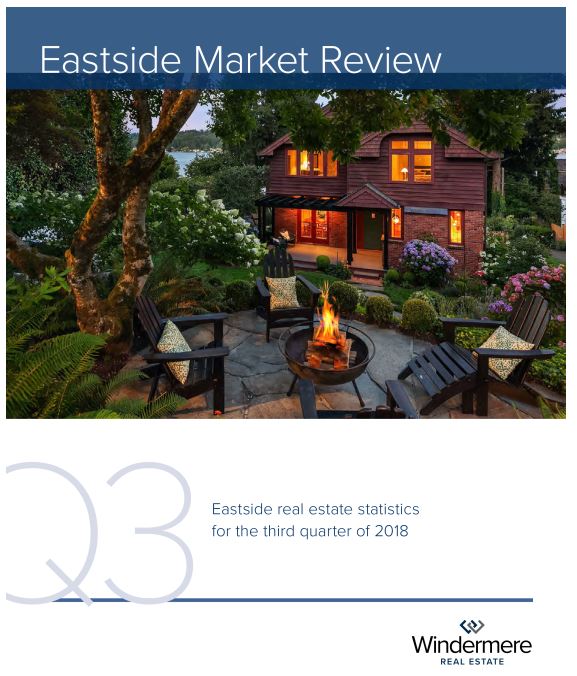Eastside communities Q3 Report for 2018

There are no major surprises to the latest sales numbers for Seattle’s Eastside communities from Renton to Bothell; East of Lake Sammamish to Kirkland & Lake Washington. Prices are mostly up, modestly in most areas but a few with price reductions over 2017 prices. Inventory levels have doubled their 2017 levels and the sales pace has varied from stable or slightly higher to as much as 25% off 2017 levels. That said, sales pace has been above the 10 yr average in all areas. With the winter season upon us, it’s likely we’ll see continued slowing in the pace and flat to lowering prices. With the amount of economic growth in our overall region and the Eastside cities in particular, these numbers are “the break” in the market that most buyers have been asking for since 2015. Inventories typically decline as we get further in to winter but I expect we’ll see a quicker bounce back up in homes for sale after the New Year. Let me know if you’d like more specific market details on areas of interest to you.
Take a look at the numbers and some of the Giving Back that Windermere has done in 2018 and some of the stats that show Windermere is still the most respected and dominant real estate company in our region. I’m grateful to have called it home since 1989.
Winter Time Home Sales?
Here's an interesting article on the benefits of selling your home in the winter time. While many of us may not want to do this directly over the holidays, those are now past and Februray will be here soon. With near record low inventory levels for good homes in the general Seattle and Eastside areas and fantastic interest rates, thought you might find this interesting. Let me know if you'd like to discuss your specific circumstances or concerns.
Winter Is Best Time to Sell, Study Shows
The housing market doesn’t hibernate in the winter. Sellers who list and buyers who buy often find the winter season the most advantageous time to make a move in real estate, according to a new study by the real estate brokerage Redfin. The winter season officially takes place between Dec. 21 and March 20, and real estate professionals should be ready for a season that often brings in more focused and active sellers and buyers.
The study found that February is “historically the best month to list, with an average of 66 percent of homes listed then selling within 90 days,” according to Redfin’s research.In an update to a two-year analysis it completed last year, Redfin researchers studied nationwide home listings, sales prices, and time-on-market data from 2010 through October 2014.
Even in cold weather cities – such as Boston and Chicago – researchers found that home sellers were better off listing their homes in the winter than during other seasons.
The winter tends to net sellers’ more than their asking price during the months of December, January, February, and March than listings from June through November. Listing during those four winter months has resulted in higher percentages of above-asking-price sales than listing during any months, other than April and May.
Redfin researchers found that in 2012 December listings were producing the highest percentage of above-asking sales for the entire year at 17 percent.
Researchers say the winter market is less competitive for sellers since many people tend to wait until the spring to list. The smaller inventory of active listings help sellers get more attention from buyers on their properties. Also, many large corporations often transfer employees or hire new ones early in the year, creating opportunities for winter sellers from very motivated purchasers.
Homes that are “priced right and show well can sell any time” of the year, says Nela Richardson, chief economist for Redfin. Winter buyers tend to be “serious buyers… Most people are not window-shopping” in December and January, like they do in the spring months, Richardson adds.
Sellers shouldn’t worry about the holidays hampering their chances either. A 2011 study conducted by realtor.com® found that 60 percent of real estate professionals advise their sellers to list a home during the holidays because they believe it’s an opportune time to sell. Nearly 80 percent of the real estate professionals surveyed said that more serious buyers emerge during the holidays, and 61 percent say less competition from other properties makes it an ideal time to sell.
As for buyers, they may find winter a good time to make a move too. Sellers often are more flexible about negotiations over prices and terms than they would in the spring, real estate professionals say.
“People get more realistic at this time of year,” particularly if their homes hadn’t sold during the summer and fall, says Mary Bayat, a broker in Washington, D.C., and chairwoman-elect of the Northern Virginia Association of REALTORS®.
Source: “Best Time to List a Home for Sale? Winter, Redfin Says,” Los Angeles Times (Dec. 14, 2014)
 Facebook
Facebook
 Twitter
Twitter
 Pinterest
Pinterest
 Copy Link
Copy Link


